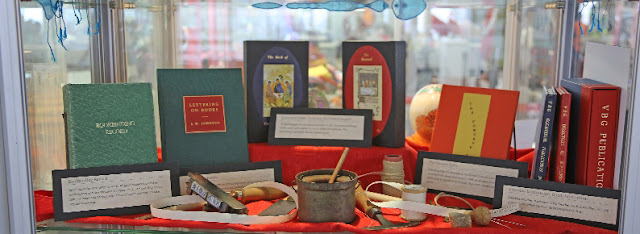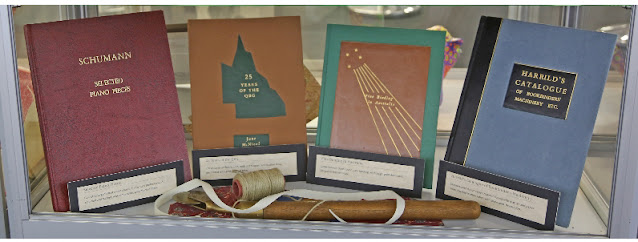A Tribute to John Willis - Royal Melbourne Show Display (updated 2021)
A Tribute to Dr John Willis
World renowned scientist, a loving family man, active Christian, pianist, amateur bookbinder, long term member of the Prayer Book Society, long -time member of the Victorian Bookbinders Guild, regular entrant (and award winner) in Melbourne Royal Show (RASV) bookbinding competitions.An intelligent, wise man with a wide range of gifts, which he used in service of others.
A Tribute From a professional colleague:
Dr. John B. Willis, world renowned scientist formerly at CSIRO Division of Chemical Physics, my colleague, mentor and friend. I had the privilege of working with John in the 1970's when he invented the revolutionary nitrous oxide burner for use in Atomic Absorption Spectroscopy. I will remember him not only for his many important contributions to spectroscopy but as a humble, generous, helpful, kindly person, who touched many, many, people with his attributes both at home and worldwide.
- Jon Van Loon, Toronto Ontario Canada
Scroll down to see details of the display
Top shelf (left to right)
Life Membership Certificate
Victorian Bookbinders Guild presented to Dr John Willis. Leather covered, with moiré pattern silk doublures, and hand calligraphy. Bound by an unknown Guild Member. ( if you know the binder, we will be pleased to know so it can be attached to the collection)The Bible
The Bible was John’s ultimate reference. Though this hasn’t been rebound, it is part of the testimony of his life. Throughout history, Christians have been known as The People of The Book.
Second shelf (left to right)
Bookbinding RecordJohn’s book for recording his work. All good binders record their work history and any special techniques used. Sections stitched on tape, rounded and backed, with a heavy boards and cloth to take regular heavy use.
Lettering on Books by Johnson
A single section binding with an interesting moiré pattern cloth, and red leather title label, with blocked gold lettering
Illustrated Prayer Book and Illustrated Gospels
A matching pair of book boxes to protect a pair of matched bindings. Cloth covers with leather on-lay to reflect the contents. The illustrations are inlaid into the leather panel.
The Concave Spine
A binding style the opposite to the standard convex rounded spine. Developed by James Brockman in 1995, as an experimental alternative to standard techniques. Full cloth, casebound with paper labels.
Victorian Bookbinders Guild Publications
Matched volumes casebound in half leather, with cloth sides, in a slip case with protective chemise. Gold foil blocked titles.
Third shelf (left to right)
Practical Bookbinding PearsonA rounded and backed case binding, in quarter cloth, with paper sides, and gold tooling. Marbled end papers, with matching buckram cloth slipcase.
V.B.G. Occasional Publication 2
A Danish Millimetre Binding designed in the post war era to minimise the use of scarce leather, and promote high accuracy binding. With marbled paper sides, leather spine and board corners. Leather blocking on the spine prior to attachment, and blocked label for the front.
Modern Bookbinding, Vaughan
A rounded and backed case binding, in full cloth, with gold blocked title, and cloth spine label.
Thomas Cranmer
Case bound, square back, cloth with gold title and decoration, in a slipcase with chemise.
Fourth shelf (left to right)
Selected Piano Pieces Schuman
Collected large format music sheets, thesis style perfect bound, rounded and backed, with cloth cover, gold blocked titles.
25 Years of the QBG
Thesis style perfect bound, with cloth cover, and leather inlay, decorated with gold blocked titles.
Fine Binding In Australia
Large format, cloth cover, case binding with large gold decorated kangaroo leather inlay.
Harrild’s Catalogue of Bookbinder’s Machinery
Sections stitched on tapes, quarter bound with leather and paper sides, blocked leather label, with some gold decoration.
During his nearly forty years at CSIRO, John helped to develop the Atomic Absorption Spectrophotometer which earned him a significant reputation as an eminent research scientist and earned the Australian Government significant royalties. He also developed a revolutionary nitrous oxide burner to use with the instrument. Because of his expertise in the area, he was awarded travel fellowships that took him back to the UK in 1963 and to the United States in 1967 – 8. He was appointed a Fellow of the Royal Australian Chemical Institute in 1957 and was the inaugural recipient of their Analytical Chemistry Medal in 1983.
After his return from England, John married Bettina Fletcher in 1953. They had two children. They were happily married for 47 years, although Betty’s last years were blighted by her Parkinson’s Disease which meant that John was her full-time carer. He looked after her faithfully. He was in turn, a devoted son, brother, husband, father, grandfather and great grandfather.
Aside from his work and family, John’s interests were many and varied. He took up piano lessons again in his late seventies, having learnt as a teen and young man. He continued his lessons until about a year before his death at the age of ninety-six. He took up bookbinding as a hobby after his retirement, feeling he needed “something to do”. He won several prizes at a number of Royal Agricultural Society of Victoria shows. He bound many books for friends and family, particularly enjoying the challenge of binding old books, including prayer books and books “special” to the owner. He also kept an eye out for old piano music that he would obtain, put in a new binding and keep, or give to his daughter, also a pianist. He was a devout Christian, worshipping regularly at St James the Great, East St Kilda. He wrote a history of this church, published a year before his death. He was also a member of the (Anglican) Prayer Book Society (where his bookbinding skills came to the fore re-binding old prayer books). He was also a member of the Port Phillip Probus Club.
John is missed by many.
Collected large format music sheets, thesis style perfect bound, rounded and backed, with cloth cover, gold blocked titles.
25 Years of the QBG
Thesis style perfect bound, with cloth cover, and leather inlay, decorated with gold blocked titles.
Fine Binding In Australia
Large format, cloth cover, case binding with large gold decorated kangaroo leather inlay.
Harrild’s Catalogue of Bookbinder’s Machinery
Sections stitched on tapes, quarter bound with leather and paper sides, blocked leather label, with some gold decoration.
Biography
John Willis was born in 1922 in Birkenhead in England, just across the River Mersey from Liverpool. He came to Australia with his family in 1935. He gained a Master of Science from Sydney University in 1944, winning several medals including the University Medal for Inorganic and Physical Chemistry. In 1946, he returned to England and completed a PhD in Inorganic Chemistry at University College, London. He then returned to Australia and worked for what became the Commonwealth Scientific and Industrial Research Organisation (CSIRO). In 1961, he was awarded a Doctor of Science for published work, again from University College London.During his nearly forty years at CSIRO, John helped to develop the Atomic Absorption Spectrophotometer which earned him a significant reputation as an eminent research scientist and earned the Australian Government significant royalties. He also developed a revolutionary nitrous oxide burner to use with the instrument. Because of his expertise in the area, he was awarded travel fellowships that took him back to the UK in 1963 and to the United States in 1967 – 8. He was appointed a Fellow of the Royal Australian Chemical Institute in 1957 and was the inaugural recipient of their Analytical Chemistry Medal in 1983.
After his return from England, John married Bettina Fletcher in 1953. They had two children. They were happily married for 47 years, although Betty’s last years were blighted by her Parkinson’s Disease which meant that John was her full-time carer. He looked after her faithfully. He was in turn, a devoted son, brother, husband, father, grandfather and great grandfather.
Aside from his work and family, John’s interests were many and varied. He took up piano lessons again in his late seventies, having learnt as a teen and young man. He continued his lessons until about a year before his death at the age of ninety-six. He took up bookbinding as a hobby after his retirement, feeling he needed “something to do”. He won several prizes at a number of Royal Agricultural Society of Victoria shows. He bound many books for friends and family, particularly enjoying the challenge of binding old books, including prayer books and books “special” to the owner. He also kept an eye out for old piano music that he would obtain, put in a new binding and keep, or give to his daughter, also a pianist. He was a devout Christian, worshipping regularly at St James the Great, East St Kilda. He wrote a history of this church, published a year before his death. He was also a member of the (Anglican) Prayer Book Society (where his bookbinding skills came to the fore re-binding old prayer books). He was also a member of the Port Phillip Probus Club.
John is missed by many.
-
Presented by: The Victorian Bookbinders Guild.
See the website www.vbgnet.au for information on meetings, activities, classes, equipment, and materials for bookbinding and book arts.
Contact president{at}vbg.net.au for any enquiries about this display or bookbinding in general.
See the website www.vbgnet.au for information on meetings, activities, classes, equipment, and materials for bookbinding and book arts.
Contact president{at}vbg.net.au for any enquiries about this display or bookbinding in general.






